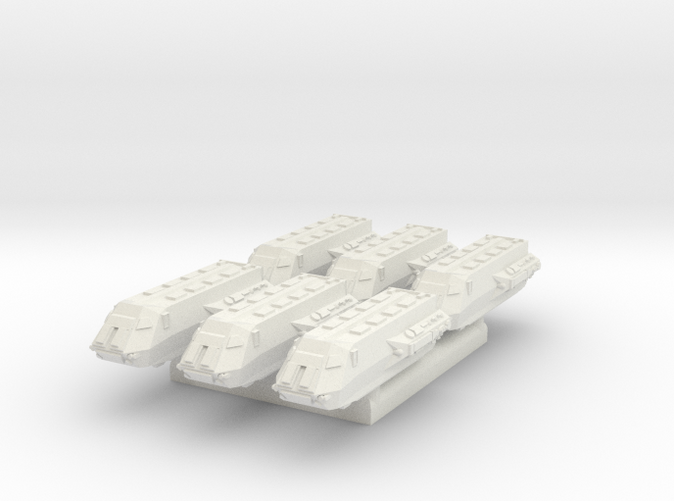Product Description
Xavek-Manfeld (Civilian)
The Xavek-Manfeld (the “x” is pronounced “ks”) !O-2300 is a typical In-System/Orbital Lander – ISOL or, as they are more colloquially known in human space, “space truck”. (The “!” is an alveolar or postalveolar click in Venerian; the proper pronunciation is difficult for humans that do not use clicking languages and has vernacularized into a click of the tongue.)
Space trucks are the basic workforce of in-system transport systems. These vessels are used to transfer cargo from the larger freighters, cargo haulers and orbital docking yards to the surface or between planets and moon and other short-haul trips. While large bulk cargos of the same goods are usually transferred directly to the receiving facility, mixed cargo for intermodal shipping needs to get the varied goods out to all over a globe. Space trucks represent the most efficient way to transfer small loads to the surface, either directly to a company landing pad, or to a road, rail or gravway transport system. While in some more advanced powers, teleportation is used for small loads (like people), in general, it remains too power inefficient for widespread use, as the sheer volume of goods makes it impractical.
The !O series is a long-standing mainstay of the space truck industry and they are often known informally as “exmans” or “xmans.”
Introduced in 2298, the !O-2300 quickly achieved a reputation for being rugged, reliable, power-efficient and adaptable, and the brand has continued to the present with annual or bi-annual models with incremental improvements.
The !O-2300 has only modest acceleration of 24mc, which is more than sufficient for in-system flights. While slow, it is quite agile, rated up to 350 MEUs, quite sufficient for even difficult docking or landing gaps. This is one of the reasons for its popularity.
The base !O-2300 model comes fitted with a small civilian hyperdrive, suited for in-system hops or short interstellar jaunts. Models used only for local transport usually remove the system for a little more storage space or just to reduce weight and power-consumption. The space truck’s crew compartment is quite spacious. Conventional usage is handled by a single crewperson, but there is seating for two additional people as standard. A tiny fold-out bunk, kitchenette and toilet facility provision for longer flights.
To protect the crew and cargo against atmospheric mishaps, weather and other hostile environments – as well as some protection from raiders, the !O-2300 has an integral shield array that is rated to a respectable 150TXq.
So from these basic design, the !O-2300 and its descendants have been adapted for almost every purpose, including passenger transport, ambulance, search-and-rescue, fire-fighter and exploration. Some models that work exclusively at docking yards remove the entire cargo bay and add larger engines at the rear, replacing the cargo bay area with towing arrays or tractor beams for moving containers around – even those much larger than the space truck itself.
